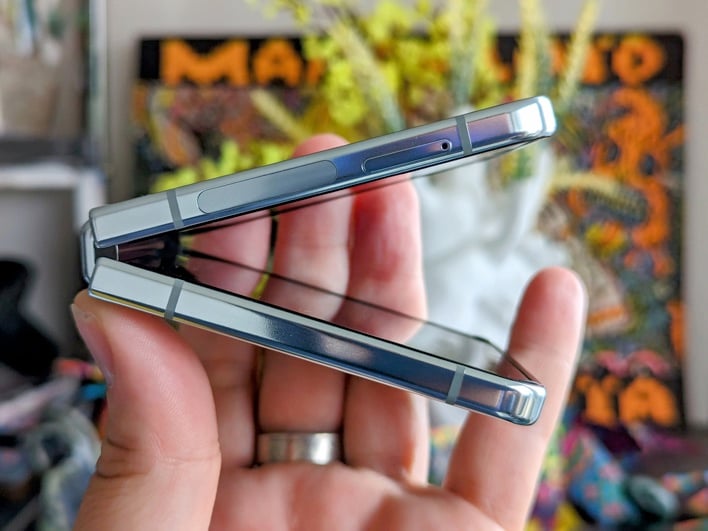Samsung Galaxy Z Flip5 And Z Fold5 Review: The Folding Phones To Beat
Samsung Galaxy Z Flip5 And Z Fold5 Review: Audio Quality, Performance, And Battery Life
We tested the Galaxy Z Flip5 and Z Fold5 on T-Mobile and Telus’
sub-6GHz 5G and 4G LTE networks in San Francisco and Vancouver (Canada),
and didn’t run into any problems. Calls sounded loud and clear, and data
speeds matched our expectations. Both folding phones support mmWave 5G and
dual SIMs (nano SIM plus eSIM), and are certified for all three major US
carriers. Our review units also worked on AT&T and Verizon’s 5G
networks.
Samsung Galaxy Z Flip5 and Z Fold5 Audio, Data, and Call Reception
On the audio front, the Z Flip5 and Z Fold5 feature stereo speakers with Dolby Atmos. Sound quality is pretty decent overall, but the Z Fold5’s speakers sound slightly better than the Z Flip5’s – likely due to additional internal real estate. These foldable handsets also include aptX HD and LDAC for high-quality wireless audio over Bluetooth, but only support digital USB Type-C devices, so you’ll need an external DAC / dongle for wired audio.
Samsung Galaxy Z Flip5 and Z Fold5 Performance
As we mentioned above, the Galaxy Z Flip5 and Z Fold5 are powered by a
binned version of Qualcomm’s flagship 4nm SoC – the Snapdragon 8 Gen 2 for
Galaxy – that’s capable of higher peak clock speeds (3.36GHz) on the X3
performance core. It’s paired with either 8GB of RAM and 256GB / 512GB of
UFS 4.0 storage (Z Flip5) or 12GB of RAM and 256GB / 512GB / 1TB of UFS 4.0
storage (Z Fold5). There’s no microSD support.
Day-to-day, Samsung’s latest folding phones feel pleasantly quick, juggling everything from communication, productivity, and entertainment apps without skipping a beat. In fact, we didn’t notice any significant difference in speed or smoothness compared to Samsung’s Galaxy S23 series, which uses the same binned chip. But while subjective performance is excellent, our benchmarks (see below) tell a different story.
Generally speaking, the Z Flip5 and Z Fold5’s benchmark results match the other Snapdragon 8 Gen 2-equipped handsets we’ve reviewed in most circumstances. But there’s one area of concern -- especially for gamers -- and that’s with heavy sustained workloads. Here the Z Flip5 (in particular) and the Z Fold5 experience significant thermal throttling, dropping to 36.8% and 63.4% – respectively – of their initial score during 3DMark’s Wild Life stress test.
Obviously, this isn’t going to be a deal breaker for most everyday tasks, since neither foldable handset is marketed to hard-core gamers. It’s just something to keep in mind if sustained performance really matters to you.
Day-to-day, Samsung’s latest folding phones feel pleasantly quick, juggling everything from communication, productivity, and entertainment apps without skipping a beat. In fact, we didn’t notice any significant difference in speed or smoothness compared to Samsung’s Galaxy S23 series, which uses the same binned chip. But while subjective performance is excellent, our benchmarks (see below) tell a different story.
Generally speaking, the Z Flip5 and Z Fold5’s benchmark results match the other Snapdragon 8 Gen 2-equipped handsets we’ve reviewed in most circumstances. But there’s one area of concern -- especially for gamers -- and that’s with heavy sustained workloads. Here the Z Flip5 (in particular) and the Z Fold5 experience significant thermal throttling, dropping to 36.8% and 63.4% – respectively – of their initial score during 3DMark’s Wild Life stress test.
Obviously, this isn’t going to be a deal breaker for most everyday tasks, since neither foldable handset is marketed to hard-core gamers. It’s just something to keep in mind if sustained performance really matters to you.
Samsung Galaxy Z Flip5 and Z Fold5 Geekbench Results
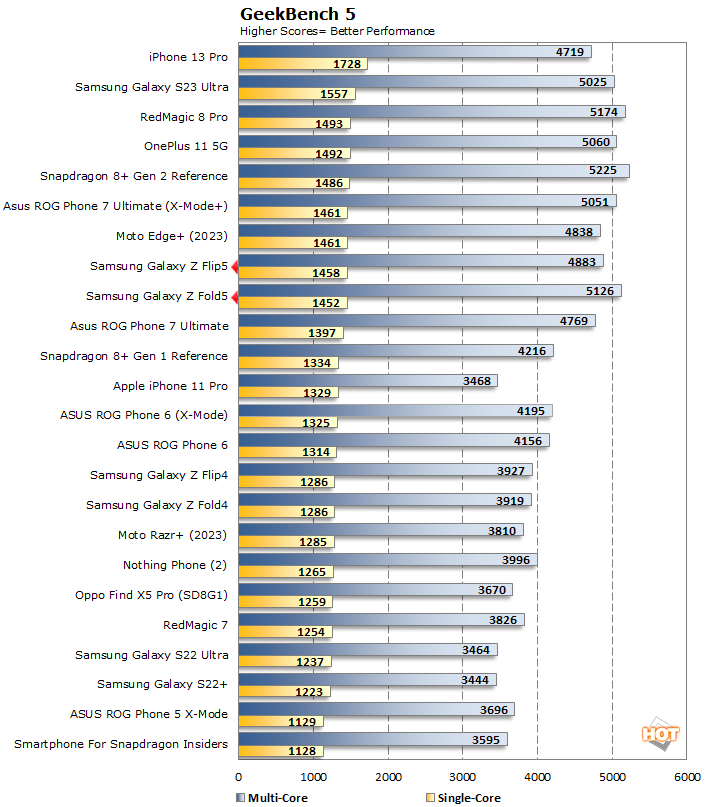
GeekBench is a purely synthetic benchmark and can be heavily targeted
for optimization. Regardless, the Snapdragon 8 Gen 2 processor delivers a
notable improvement in single and multi-threaded performance over previous
generation Snapdragon
8
Gen 1-equipped Android flagships.
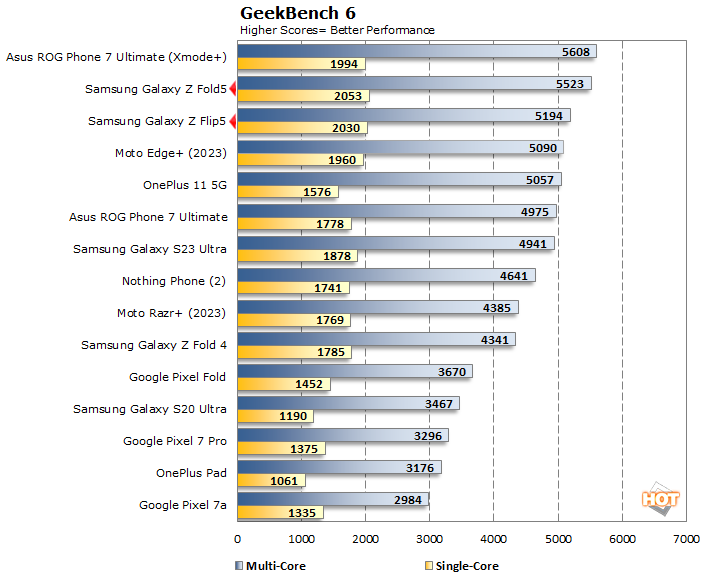
Recently, Geekbench was upgraded to version 6, which includes new ways
of testing multicore configurations and uses higher-resolution assets.
Since this benchmark is brand new, we don't have as many data points, but
as you can see, the Galaxy Z Flip5 and Z Fold5 performed quite well in
this test.
Samsung Galaxy Z Flip5 and Z Fold5 PCMark For Android Benchmarks
Futuremark's PCMark for Android is an excellent suite of tests if you
want to benchmark a wide range of tasks on any handset -- things like
image and video editing, as well as lighter-duty, everyday workloads such
as email and web browsing. When you see the test running live, it's clear
the scripted application tests are carefully selected and tuned to make
use of the each mobile platform in a very controlled way...

Here the Galaxy Z Flip5 and Z Fold5 shows similar performance to
current Snapdragon 8 Gen 2-equipped devices, slotting near the RedMagic
8 Pro.
Samsung Galaxy Z Flip5 and Z Fold5 AnTuTu 8 Benchmark Results
AnTuTu’s latest benchmark returns a number of metrics ranked with
somewhat nebulous scores, rather than frame rates or time to complete.
Here we're running the latest version of AnTuTu across multiple Android
devices. AnTuTu returns four top level performance results which are all
included here: CPU, RAM, 3D, UX (or User Experience), along with a total
score...


According to AnTuTu, the Galaxy Z Flip5 and Z Fold5 offers similar
performance to other Snapdragon 8 Gen 2 Android handsets, putting them
right alongside the OnePlus 11 5G in terms of overall score.
However, in AITuTu, which is specifically an image recognition and classification benchmark for AI and machine learning workloads, we see a different picture. Here there are big gains for Snapdragon 8 Gen 2 powered devices like the Galaxy Z Flip5 and Z Fold5. In fact, the Z Fold5 achieves our highest score yet in this test.
However, in AITuTu, which is specifically an image recognition and classification benchmark for AI and machine learning workloads, we see a different picture. Here there are big gains for Snapdragon 8 Gen 2 powered devices like the Galaxy Z Flip5 and Z Fold5. In fact, the Z Fold5 achieves our highest score yet in this test.
3D Graphics And Gaming Benchmarks With The Samsung Galaxy Z Flip5 and Z Fold 5
Next we're checking how the Galaxy Z Flip5 and Z Fold5 compare in
GFXBench, which has been one of the standard mobile graphics/gaming
performance benchmarks for years. To ensure that display refresh (v-sync)
and resolution aren't limiting factors, we're comparing off-screen test
results here. GFXBench tests OpenGL ES graphics workloads and we're
specifically testing OpenGL ES 2.0 and 3.0.


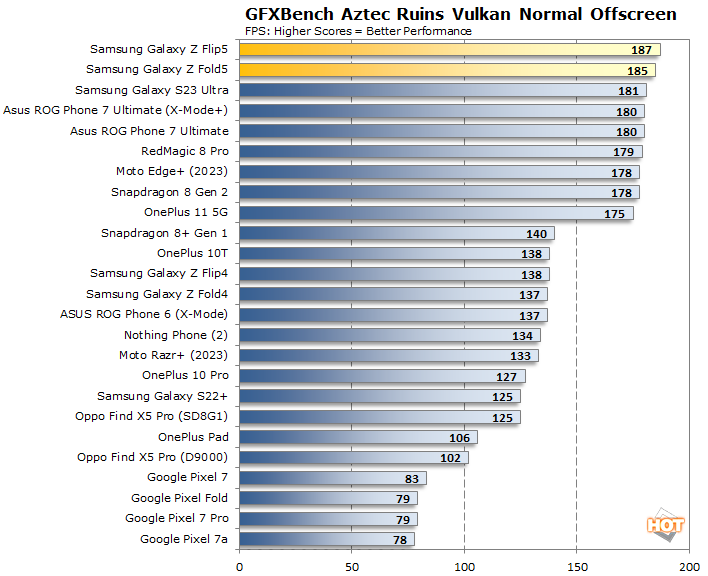
Now we're seeing the kind of performance improvement we expected from
Snapdragon 8 Gen 2-equipped devices like the Galaxy Z Flip5 and Z Fold5.
T-Rex benchmark aside, both folding phones clearly beat Snapdragon 8 Gen
1-powered devices like the ROG Phone 6 in these graphically rich
benchmarks, and even take our top ranking in the Aztec Ruins benchmark.
Futuremark's 3DMark Sling Shot is a newer benchmark module that's been added to the 3DMark mobile suite. Unlike previous gen 3DMark mobile tests, Sling Shot is a much more advanced OpenGL ES 3.1 and Metal API-based benchmark that employs more advanced rendering techniques, like volumetric lighting, particle illumination, multiple render targets, instanced rendering, uniform buffers and transform feedback.
Futuremark's 3DMark Sling Shot is a newer benchmark module that's been added to the 3DMark mobile suite. Unlike previous gen 3DMark mobile tests, Sling Shot is a much more advanced OpenGL ES 3.1 and Metal API-based benchmark that employs more advanced rendering techniques, like volumetric lighting, particle illumination, multiple render targets, instanced rendering, uniform buffers and transform feedback.

3DMark Sling Shot Extreme Benchmark
We're running this test in off-screen mode once again to remove
display resolution differences from the equation. This lets us compare
cross-platform results more reliably...

Here we only see a slight improvement to the overall score over
Snapdragon 8 Gen-1-equipped flagships. Still, the Galaxy Z Flip5 and Z
Fold5 performed well in this test, slotting near the Snapdragon 8 Gen
2-equipped OnePlus 11 5G and Galaxy S23 Ultra.
Samsung Galaxy Z Flip5 and Z Fold5 3DMark Wild Life Benchmark Tests
3DMark Wild Life is the latest cross-platform test from UL. Its
primary purpose is to measure GPU performance across platforms, and two
distinct tests are available. The standard Wild Life test is designed to
give feedback on how a game performs over a short period of time. With
mobile games, people typically play in brief spurts when they find some
free time; be it on the bus, on the subway, or a quick battle royale
session over lunch break. The 3DMark Wild Life Stress Test, on the other
hand, shows how a device performs over a longer stretch of time, and
takes note of performance degradation that might crop up due to
increased heat levels and throttling.
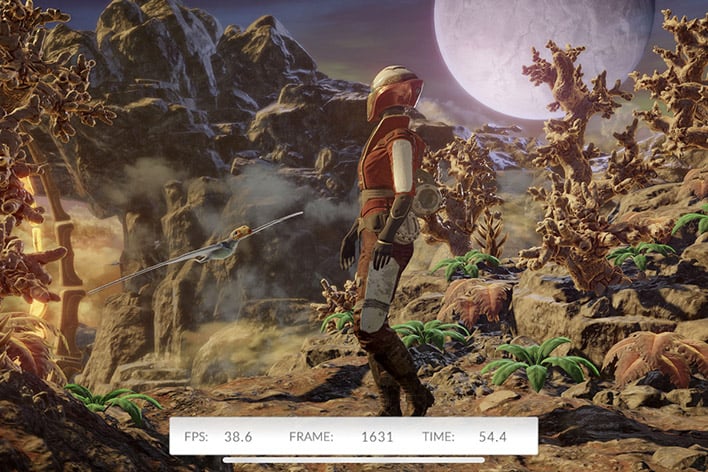

3DMark Wild Life is a significantly more taxing graphics benchmark
that employs cutting-edge mobile game engine technologies to deliver
impressive visuals -- as you can see in the screen shot above.
Here the Galaxy Z Flip5 and Z Fold5 make it to the top of our
scoreboard, and deliver a massive improvement in performance
versus the fastest Snapdragon 8 Gen 1-equipped devices. They even come
out ahead of the RedMagic 8 Pro, which is an actively-cooled gaming
phone that's also powered by the Snapdragon 8 Gen 2.
Unfortunately, the Galaxy Z Flip5 does exhibit significant throttling,
managing a stability score of just 36.8% in the Wild Life Stress test. The
Z Fold5 fares marginally better here, with a stability score of 63.4%.
Samsung Galaxy Z Flip5 and Z Fold5 Other Features and Battery Life
The Z Flip5 and Z Fold5’s remaining specs are on par with most other
Snapdragon 8 Gen 2 flagships. Both include sub-6GHz and mmWave 5G (SA /
NSA), CAT 22 LTE, tri-band WiFi 6e (802.11ax), Bluetooth 5.3 (LE), NFC,
UWB, dual-band A-GPS / GALILEO / BDS / GLONASS positioning – along with
the usual array of sensors on board (ambient light, proximity,
accelerometer, gyro, compass, and barometer).
Rounding things up, the Z Flip5 and Z Fold5 feature high quality haptics thanks to a linear vibration motor. The side-mounted capacitive fingerprint sensor is fast and reliable. Face unlock is also available, and also works well. Both folding phones support 25W wired charging (USB PD) and 15W Qi compatible wireless charging – plus 4.5W reverse wireless charging. As usual with Samsung's latest devices, there’s no charger supplied in the box.
Battery life on these two foldable handsets is fine, but not spectacular. Just like their predecessors, the Z Flip5 and Z Fold5 pack 3700mAh and 4400mAh batteries, respectively, and scored 10h 48m and 11h 51m, respectively, in our PCMark Work 3.0 battery test. Still, we’re pretty confident these two folding phones will last an entire day of regular use for most people. Just don’t expect the same endurance as a standard flagship with a single display and a 5000mAh battery.
Next up: the software, pricing, and the review verdict...
Rounding things up, the Z Flip5 and Z Fold5 feature high quality haptics thanks to a linear vibration motor. The side-mounted capacitive fingerprint sensor is fast and reliable. Face unlock is also available, and also works well. Both folding phones support 25W wired charging (USB PD) and 15W Qi compatible wireless charging – plus 4.5W reverse wireless charging. As usual with Samsung's latest devices, there’s no charger supplied in the box.
Battery life on these two foldable handsets is fine, but not spectacular. Just like their predecessors, the Z Flip5 and Z Fold5 pack 3700mAh and 4400mAh batteries, respectively, and scored 10h 48m and 11h 51m, respectively, in our PCMark Work 3.0 battery test. Still, we’re pretty confident these two folding phones will last an entire day of regular use for most people. Just don’t expect the same endurance as a standard flagship with a single display and a 5000mAh battery.
Next up: the software, pricing, and the review verdict...

